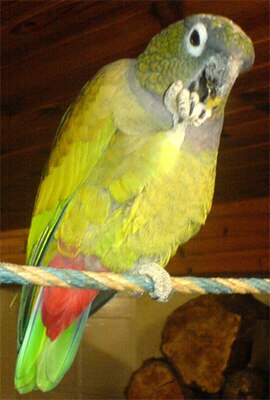Maximilian Parrot
| Maximilian Parrot | ||||||||||||
|---|---|---|---|---|---|---|---|---|---|---|---|---|

Maximilian parrot ( Pionus maximiliani ) |
||||||||||||
| Systematics | ||||||||||||
|
||||||||||||
| Scientific name | ||||||||||||
| Pionus maximiliani | ||||||||||||
| ( Kuhl , 1820) |
The Maximilian parrot ( Pionus maximiliani ) is a real New World parrot from the genus of the red-faced parrot . The specific epithet honors Prince Maximilian zu Wied-Neuwied , who discovered him at the beginning of the 19th century .
Distribution area
The Maximilian parrot inhabits the area from northern Argentina to north of Ceará , Piauí and Goiás in Brazil .
features
The Maximilian parrot reaches a total length of 29 cm. The plumage is predominantly pale green, the underside is paler and tinted bronze-brown. The forehead and reins are black, the green cheek feathers are lined with a bluish tinge. The chin and throat are green with blue banding in the throat area. The feathers on the back, rump, wings, chest and belly are dark olive green. They are lighter on the arm covers and the undersides of the wings are dark blue-green. The outer wings of the hand have a green-blue border on the outer flags. The under wing coverts and the underside of the wings are dull green. The under tail coverts are coral red, individual feathers are bordered blue-green. The control springs are green, the outer ones have a blue outside flag. The inside flag is green at the top and turns red towards the base. The beak is yellowish horn-colored and dark gray at the base. The iris of the birds is brown, the color of the orbital ring ranges from light gray to white. The legs and feet are gray. No sexual dimorphism can be seen in the Maximilian parrot.
The young birds look similar to the adult birds. Their feathers on the head are paler and the forehead feathers are yellow-orange or reddish in color. The blue collar, which stands out clearly in the adult birds, is not yet pronounced in the young birds and the red under-tail cover of the young is still lined with light green.
Subspecies
- Pionus maximiliani maximiliani ( Kuhl , 1820) - The nominate form is described above. It occurs in northeast and central Brazil.
- P. maximiliani melanoblepharus Miranda-Ribeiro , 1920 - chin and chest area are dark blue, the back and the underside are darker green than in the nominate form described above and the subspecies is slightly larger. The young birds are similar to those of P. m. maximiliani , however, are a little darker green. The distribution area extends from south-east Brazil, over east Paraguay to north Argentina.
- P. maximiliani syi Souancé , 1856 - This subspecies is similar to P. m. melanoblepharus , but the chin and collar are colored purple with blue spots on some throat feathers. The back plumage and the underside are of a paler green and shimmering bronze. The young birds look like those of P. m. maximiliani only olive green. The distribution area extends from eastern Brazil, via eastern Bolivia and Paraguay to northern Argentina. In east Brazil the subspecies mixes with P. m. melanoblepharus .
- P. maximiliani lacerus ( Heine , 1884) - The plumage is like that of P. m. Syin colored, but the collar is wider and has a more intense blue. The young birds look like those of P. m. syi . The distribution area is in northern Argentina, where the subspecies with P. m. syi mixed.
Way of life
The Maximilian parrot inhabits open forests, palm groves and bush savannahs in the tropical zone. The birds are usually seen in pairs, singly, or in small groups. They are hardly noticeable in the trees, as the green plumage in the treetops hardly stands out from its surroundings. While the parrots only chatter softly when they rest and eat, they are very loud in flight and can be heard from afar.
The diet of the Maximilian parrots consists of fruits, berries and seeds. It is believed that they also feed on the flowers of fruit trees.
population
The ongoing deforestation in South America hardly seems to burden the Maximilian parrot, so that there is only a slight decline in the species. Together with the brown-eared parakeet , the Maximilian parrot is the most widespread and numerically most represented parrot in its habitat. The species is therefore classified by the IUCN as “least concern”.
source
literature
- Susanne and Werner Lantermann (1986): The parrots of Central and South America: Species, keeping and breeding , Verlag M. & M. Schaper, ISBN 3-7944-0149-2
- Dieter Hoppe : Parakeets and Parrots , Ulmer Verlag, 2nd edition, 2007, ISBN 978-3-8001-5566-8
Web links
- Pionus maximiliani inthe IUCN 2012 Red List of Threatened Species . Listed by: BirdLife International, 2012. Retrieved January 9, 2013.
- Videos, photos and sound recordings of Scaly-headed Parrot (Pionus maximiliani) in the Internet Bird Collection
- www.vogellexikon.de - Maximilian's Parrot